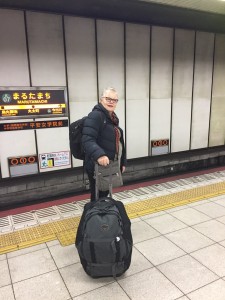Travelling is a very personal thing, and so is packing. For those of you who have mastered this unique art, well done! To the others (and I include myself in this category),why not take a leaf out of Marie Kondo’s book ‘The Life Changing Magic of Tidying Up’?She devised the famous KonMari Method and is a pro organiser with a minimalist inspired approach to tidying. *Check out her 6 basic rules for decluttering your home below.
I have discovered that the KonMari method is also perfect for packing. Simply take out any item that doesn’t bring you joy when you make your final pack, and hopefully this will lighten your luggage.
On my two recent trips to Japan I traveled mostly by train and often had several flights of stairs to

maneuver to get to platforms. Once I was on the train I discovered that the luggage storage was usually overhead (particularly on the Shinkensen or bullet trains) and I needed to be able to do this myself rather than relying on the kindness of strangers (Japanese people are reserved and don’t usually offer to help). It is a struggle either way, but less of one if your bag is light. On the first trip I had 17kgs which was too heavy and during the second trip I had reduced it to 14kgs, which was about right.One of my travelling companions on my first visit had a suitcase of around 25kgs. This person was a novice traveler and we all nearly broke our backs juggling to pick it up to store it overhead. He ended up buying another bag and splitting the contents. I have discovered that aiming to sit around 15kgs is a good rule of thumb.
Travelling further afield to India, if you are taking an internal flight to a regional area (e.g. Delhi to Dharamsala), the airlines will restrict your check in luggage to 15kgs and usually charge for each kilogram over 16kgs. This can become a costly addition to your holiday if you are taking a few of these internal flights. The same applies for domestic flights in Australia – if you learn the art of packing lightly then there is no need to pay for luggage (e.g. when flying on Jetstar) and the bonus of not having lengthy delays waiting for bags.

From my years of travelling, I have discovered that having less weight to carry around on the road saves your back and your head if you have your suitcase carefully coordinated. I prefer travelling in winter and this has a distinct advantage. You don’t sweat – so that means you can wear the same thing more than once. Rotating different tops and bottoms along with colourful scarves also means that you never get bored. Scarves, shawls and sarongs are great multipurpose travel items and can be used for so many things – to provide warmth, as something to sit on, an emergency towel or blanket or to cover up when visiting religious sites. Wool underwear is another amazing addition as it dries quickly overnight.
Summer it is a bit different but does have one advantage as you can also get wash and wear outfits that you can wash at night time and hang out to dry under some tropical night sky.
I completely understand why Marie Kondo is so famous. Next time you are about to set off on that holiday you have been so eagerly awaiting, pick up every piece of clothing that you are thinking of taking and if it doesn’t bring you joy (or practicality) leave it at home. It is definitely a case of less is best. I am certainly going to try this approach, having just booked myself a flight for 5 days with carry-on luggage only.
The minimalist approach to packing lightly is an art form and something I am embracing, and I hope you will too.
*What is the KonMari Method?
The KonMari Method is Marie Kondo’s minimalist inspired approach to tackling your stuff category-by-category rather than room-by-room. There are six basic rules to get started:
- Commit yourself to tidying up.
- Imagine your ideal lifestyle.
- Finish discarding first. Before getting rid of items, sincerely thank each item for serving its purpose.
- Tidy by category, not location.
- Follow the right order.
- Ask yourself if the item sparks joy.
To find out more visit:
https://www.goodhousekeeping.com/home/organizing/a25846191/what-is-the-konmari-method/

